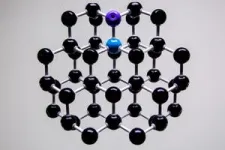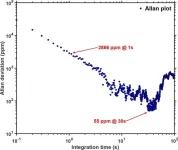(Press-News.org)
A study published today in Astronomy & Astrophysics marks a significant milestone in our understanding of the formation and dynamical evolution of multiple stellar populations in globular clusters (spherical and very compact stellar agglomerates typically populated by 1–2 million stars). This pioneering study, conducted by a group of researchers from the National Institute for Astrophysics (INAF), the University of Bologna, and Indiana University, is the first to perform a 3D kinematic analysis of multiple stellar populations for a representative sample of 16 globular clusters in our Galaxy. It provides a groundbreaking observational description of their kinematic properties (i.e., how stars move within globular clusters) and their long-term evolution from the formation to the present day.
Emanuele Dalessandro, researcher at INAF in Bologna, lead author of the article and coordinator of the working group, explains: "Understanding the physical processes behind the formation and early evolution of globular clusters is one of the most fascinating and debated astrophysical questions of the past 20–25 years. The results of our study provide the first solid evidence that globular clusters formed through multiple star formation events and place fundamental constraints on the dynamical path followed by the clusters throughout their evolution. These results were made possible by a multi-diagnostic approach and the combination of state-of-the-art observations and dynamic simulations."
The study highlights that the kinematic differences between multiple populations are key to understanding the formation and evolution mechanisms of these ancient structures.
With ages that can reach 12-13 billion years (thus dating back to the dawn of the cosmos), globular clusters are among the first systems to form in the Universe. They represent a typical population of all galaxies. They are compact systems (with masses of several hundred thousand solar masses and sizes of a few parsecs), and they can be observed even in distant galaxies.
"Their astrophysical significance is huge," says Dalessandro, "because they not only help us to test cosmological models of the formation of the Universe due to their age but also provide natural laboratories for studying the formation, evolution, and chemical enrichment of galaxies." Despite globular clusters have been studied for over a century, recent observational results show that our knowledge is still largely incomplete.
"Results obtained in the last two decades have unexpectedly shown that globular clusters consist of more than one stellar population: a primordial one, with chemical properties similar to other stars in the Galaxy, and another with anomalous chemical abundances of light elements such as helium, oxygen, sodium, and nitrogen," says Mario Cadelano, researcher at the Department of Physics and Astronomy at the University of Bologna and INAF associate, one of the authors of the study. "Despite the large number of observations and theoretical models aimed at characterising these populations, the mechanisms regulating their formation are still not understood."
The study is based on the measurement of 3D velocities, i.e., the combination of proper motions and radial velocities, obtained with the ESA Gaia telescope and with data from, among others, the ESO VLT telescope, primarily as part of the MIKiS survey (Multi Instrument Kinematic Survey), a spectroscopic survey specifically aimed at exploring the internal kinematics of globular clusters. The use of these telescopes, from space and the ground, has provided an unprecedented 3D view of the velocity distribution of stars in the selected globular clusters.
The analysis reveals that stars with different abundances of light elements are characterised by different kinematic properties, such as rotational velocities and orbital distributions.
"In this work, we analysed in detail the motion of thousands of stars within each cluster," adds Alessandro Della Croce, a PhD student at INAF in Bologna. "It quickly became clear that stars belonging to different populations have distinct kinematic properties: stars with anomalous chemical composition tend to rotate faster than the others within the cluster and progressively spread from the central regions to the outer ones."
The intensity of these kinematic differences depends on the dynamical age of globular clusters. "These results are consistent with the long-term dynamical evolution of stellar systems, in which stars with anomalous chemical abundances form more centrally concentrated and rotate more rapidly than the standard ones. This, in turn, suggests that globular clusters formed through multiple star formation episodes and provides an important piece of information in defining the physical processes and timescales underlying the formation and evolution of massive stellar clusters," Dalessandro emphasises.
This new 3D view of the motion of stars within globular clusters provides an unprecedented and fascinating framework for the formation and dynamical evolution of these intriguing systems. It also helps to clarify some of the most complex mysteries surrounding the origin of these ancient structures.
Related journal article: “A 3D view of multiple populations kinematics in Galactic globular clusters”, by E. Dalessandro, M. Cadelano, A. Della Croce, F. I. Aros, E. B. White, E. Vesperini, C. Fanelli, F. R. Ferraro, B. Lanzoni, S. Leanza, L. Origlia. In: Astronomy & Astrophysics.
Contacts:
INAF Press Office - Marco Galliani, +39 335 1778428, ufficiostampa@inaf.it
END
Hydrogen gas is a promising energy source with several advantages - it is lightweight, storable, energy-dense, and environmentally friendly compared to fossil fuels, producing no pollutants or greenhouse gas emissions. As such, it has extensive applications across different fields, including transportation, architecture, power generation, and industries. However, hydrogen is highly flammable, and therefore its safe and widespread use requires reliable methods for detecting leaks and ensuring its purity. The need for reliable detection methods has necessitated the development of trace-gas sensing techniques. While several methods have been developed for hydrogen sensing, ...
Even though psychiatric disorders such as schizophrenia, bipolar disorder, and autism spectrum disorder (ASD) are quite common, their diagnosis and treatment are challenging. While doctors today have a good idea of the clinical symptoms caused by these disorders, our overall understanding of their biological characteristics and underlying physiological causes remain obscure.
Experts agree that problems with synapses—the connections that allow communication between neurons—might be a defining feature ...
Researchers at Chalmers University of Technology in Sweden and at the University of Magdeburg in Germany have developed a novel type of nanomechanical resonator that combines two important features: high mechanical quality and piezoelectricity. This development could open doors to new possibilities in quantum sensing technologies.
Mechanical resonators have been used for centuries for a multitude of applications. A key aspect of these devices is their ability to vibrate at specific frequencies. A well-known example is the tuning fork. When struck, the tuning fork oscillates at its resonance frequency, producing a sound wave within our hearing range. ...
Iliana Ivanova, Commissioner for Innovation, Research, Culture, Education and Youth, said: “Innovation thrives on collaboration, especially when tackling the pressing scientific challenges of our time. The ERC Synergy Grants work with Horizon Europe funding to connect brilliant minds across borders and disciplines, enabling them to push the frontiers of knowledge together. I am particularly delighted to see researchers from countries with historically fewer ERC grants among the awardees, reflecting our mission to ...
The CODICUM project brings together experts in history, literature, and bio-codicology from four Nordic universities to explore medieval knowledge networks. This groundbreaking study combines traditional humanities approaches with cutting-edge biomolecular analysis of fragments from medieval books, written on animal skin.
How book culture shaped medieval Europe
The project will investigate approximately 50,000 medieval Latin book fragments preserved in Nordic collections—one of Europe’s largest archives of medieval book culture.
"These fragments represent an extraordinary treasure trove that can transform our understanding ...
The origins of writing in Mesopotamia lie in the images imprinted by ancient cylinder seals on clay tablets and other artifacts. A research group from the University of Bologna has identified a series of correlations between the designs engraved on these cylinders, dating back around six thousand years, and some of the signs in the proto-cuneiform script that emerged in the city of Uruk, located in what is now southern Iraq, around 3000 BCE.
The study—published in Antiquity—opens new perspectives on ...
Science can be difficult to explain to the public. In fact, any subfield of science can be difficult to explain to another scientist who studies in a different area. Explaining a theoretical science concept to high school students requires a new way of thinking altogether.
This is precisely what researchers at the University of California San Diego did when they orchestrated a dance with high school students at Orange Glen High School in Escondido as a way to explain topological insulators.
The experiment, led by former graduate student Matthew Du and UC San Diego Associate Professor of Chemistry and Biochemistry Joel Yuen-Zhou, was published in Science Advances.
“I ...
Tucson, Arizona, 5 November 2024 – Brain Medicine has launched an ambitious Festschrift series with the first of more than ten planned articles celebrating Dr. Seymour Reichlin's centennial year and his transformative impact on neuroendocrinology. The opening editorial, chronicling his revolutionary insights into brain-hormone interactions, inaugurates what promises to be one of the most comprehensive tributes in the field's history.
“One could be both a physician caring for patients and a scientific investigator,” reflects Dr. Reichlin, whose work spanning nearly 80 years has fundamentally reshaped our understanding of how ...
In the 1960s, Japanese books became immensely popular in South Korea. Interestingly, Korean newspapers often wrote about this trend as if mainly women were interested in learning Japanese.
Osaka Metropolitan University Associate Professor Jinsuk Yang examined South Korean newspaper articles and other historical documents from the 1960s and 1970s to understand why Japanese language learning was often described as something women did, even though men were also learning Japanese. Additionally, Professor Yang studied how women’s ability to speak Japanese affected ...
As buildings age, the demand for effective monitoring of their structural integrity has grown significantly. A breakthrough in nano-optical sensor technology now enables precise, real-time measurement of structural deformation and stability. This innovation promises to reshape the field of structural diagnostics, offering a cost-effective, time-efficient solution that reduces the need for specialized expertise traditionally required in this area.
Led by Dr. Jae Sung Yoon, Principal Researcher at the Nano-lithography & Manufacturing Research Center within the Nano-convergence ...










